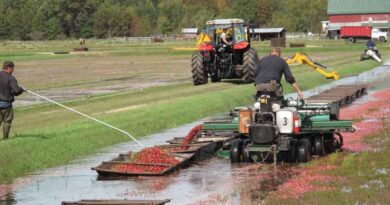USDA Research Seeks to Strengthen Cranberry Resiliency as Climate Change Affects Production
15 December 2021, US: A traditional part of every holiday meal includes some type of cranberry dish. Every year, Americans place homemade or canned cranberry sauce on the holiday dinner table. Others may use the tart-tasting blood red berry in a baked good or as a part of the table décor. Regardless of how you choose to incorporate cranberries into your meal or traditions, we can all agree it is a much sought-after item for Thanksgiving and other winter holidays. That’s why researchers at the U.S. Department of Agriculture’s Agricultural Research Service are currently working to preserve its production in the looming threat of climate change.
More extreme and hotter weather is expected with climate change, which poses challenges for current cranberry production regions. Cranberries are sensitive to heat stress, leading to declines in yield and fruit quality and increases in disease pressure. The nation’s major cranberry-production regions are also locations for major ARS-funded cranberry research (Massachusetts, New Jersey, Oregon, Washington, and Wisconsin). All of these states have experienced warming climates over last century, but the cranberry production states of New Jersey and Massachusetts have experienced some of the most rapid warming. This means that without an agricultural solution soon, the nation may end up handling fewer, smaller, or lower quality cranberries.
“It’s important for us to understand the interaction between a cranberry’s genetics and its environment,” said ARS Research Geneticist Jeffrey Neyhart. “Once we understand this interaction, we’ll be able to protect and increase productivity, fruit quality, stress tolerance, and disease resistance.”
Tapping into the wild cranberry gene pool may be one way to improve the resiliency of the cultivated cranberry as the climate continues to change. Dr. Neyhart and the research team are currently working to discover potential wild cranberry genes that are associated with various stresses.
“We were able to identify genomic segments in the wild cranberry that correlate with stresses such as extreme temperatures, soil pH, and drought,” said Dr. Neyhart. “Selecting these genomic segments in breeding can help us to efficiently move more favorable wild genetics into new cranberry varieties.”
In addition to breeding efforts, ARS researchers are also trying to better understand heat tolerance in cranberries which can lead to improved cranberry cultivar recommendations for growers based on their location or management practices. This research will be ongoing, and other solutions to this agricultural challenge will be explored as innovative cranberry research continues into 2022.
The Agricultural Research Service is the U.S. Department of Agriculture’s chief scientific in-house research agency. Daily, ARS focuses on solutions to agricultural problems affecting America. Each dollar invested in agricultural research results in $17 of economic impact.















